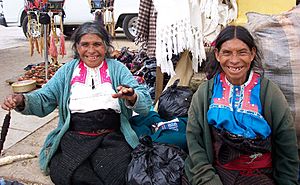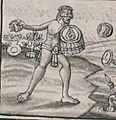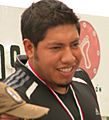Indigenous peoples of Mexico facts for kids
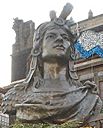 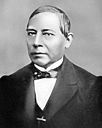 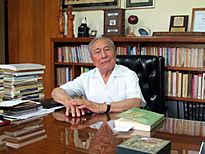 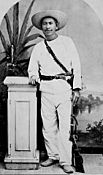 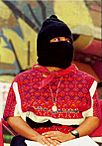
|
|
| Total population | |
|---|---|
| 25,694,928 (self-reported) or 40-65 million by estimation (including sole Spanish speakers) | |
| Regions with significant populations | |
| Yucatán, Oaxaca, Chiapas, Campeche, Veracruz, Guerrero, Hidalgo, Puebla, Michoacan | |
| Languages | |
| Nahuatl, Yucatec, Tzotzil, Mixtec, Zapotec, Otomi, Huichol, Totonac and another 54 living languages along the Mexican territory, as well as Spanish | |
| Religion | |
| Christianity (predominantly Roman Catholic, with Amerindian religious elements, including Mesoamerican religion) | |
| Related ethnic groups | |
| Indigenous peoples of the Americas |
The Indigenous peoples of Mexico are groups of people whose families have lived in what is now Mexico for thousands of years. They were there long before the Spanish arrived.
The Mexican government counts indigenous people based on whether their communities keep their traditional languages, customs, and beliefs. In 2015, about 25.7 million people in Mexico said they were indigenous. This means they make up about 21.5% of Mexico's total population.
When the Spanish first arrived in the late 1400s, there were an estimated 25 million indigenous people. It took over 500 years for the population to reach that number again.
Contents
History of Indigenous Peoples
Ancient Civilizations
The ancient civilizations of Mexico are usually split into two main areas. Mesoamerica was a region where many advanced cultures grew before the Spanish came. Aridoamerica, or "The North," was a drier area with fewer large civilizations. It was mostly home to groups who moved around a lot. Mesoamerica had many different indigenous groups. They spoke different languages but shared similar ways of life.
One very important civilization was the Olmec. Some people call them the "Mother Culture" of Mesoamerica. Later, the city of Teotihuacán became huge around 600 AD. It was one of the world's biggest cities. Its culture influenced later groups like the Toltec and Aztecs. Evidence shows that different ethnic groups lived together in Teotihuacán. The Maya developed a large cultural area in southeastern Mexico. The Zapotec and Mixtec cultures were strong in the valley of Oaxaca. The Purepecha lived in western Mexico.
Colonial Times

When the Spanish arrived, many different groups were part of the Aztec Empire. The Aztec capital, Tenochtitlan, was a massive city with about 350,000 people. During the conquest, the Spanish were very few compared to the millions of indigenous people. They used the disagreements between different groups. They made alliances with rivals of the Aztecs. These alliances helped the Spanish win.
However, the indigenous people soon faced a new powerful empire. Wars and forced labor were common. European diseases, which were new to the Americas, also spread. These diseases caused huge outbreaks, killing 90% to 95% of the population in some areas.
At first, the Spanish set up a system where indigenous people had fewer rights. But over time, cultures mixed. Indigenous people adopted parts of Roman Catholicism. A new group of people called mestizos were born. They had both European and indigenous family backgrounds.
Mexico's Independence
When Mexico became independent from Spain, it made all citizens equal under the law. Slavery was also ended. Some indigenous people became important in Mexican society. For example, Benito Juárez, who was Zapotec, became the first indigenous president in the Americas.
The Mexican Revolution in the early 1900s brought even bigger changes. It created a strong feeling that indigenous peoples were a key part of Mexico's identity. Artists like Frida Kahlo and Diego Rivera promoted this "Indigenous Sentiment." For many years, the government started bilingual education in indigenous communities. They also published free textbooks in two languages.
Despite this official recognition, many indigenous communities still face economic challenges. Thousands of indigenous Mexicans have moved to cities in Mexico or to the United States. In Los Angeles, for example, the Mexican government offers services in Spanish, Zapotec, and Mixe. Some Maya people in Chiapas have protested for better opportunities. The EZLN is one group that has spoken for them.
The government has changed laws to help rural and indigenous communities. The Mexican Constitution now gives them the right to make their own decisions. It also requires states to help their economic growth and protect their languages and traditions.
Indigenous Population and Languages
How Indigenous People Are Counted
The number of indigenous Mexicans is based on rules in the Mexican constitution. The Mexican census does not ask about race. Instead, it counts people in indigenous communities who keep their languages, traditions, and cultures.
Languages Spoken
Mexico's Law of Linguistic Rights recognizes 62 indigenous languages. These languages have the same legal standing as Spanish in the areas where they are spoken. About 5.4% of Mexico's population speaks an indigenous language. This is about half of the people who identify as indigenous. Mexico also protects the languages of indigenous groups who moved there from the United States or Guatemala.
Population Facts
In 2010, Mexico had about 14.85 million indigenous people. This was about 13% of the country's population. The total number of indigenous people is growing. However, it is growing slower than the rest of the population. This means the percentage of indigenous people is slowly getting smaller.
Most indigenous people live in the central and southern states of Mexico. These areas are generally less developed. Most indigenous people also live in rural areas. Some indigenous communities have a degree of self-rule. This means they can manage some of their own issues using their traditional laws.
The states with the largest percentage of indigenous people are:
- Yucatán, 59%
- Oaxaca, 48%
- Quintana Roo, 39%
- Chiapas, 28%
- Campeche, 27%
- Hidalgo, 24%
- Puebla, 19%
- Guerrero, 17%
- San Luis Potosí, 15%
- Veracruz, 15%
In Yucatán, Quintana Roo, and Campeche, most indigenous people are Maya. In Oaxaca, the largest groups are the Mixtec and Zapotec peoples. Chiapas has many Tzeltal and Tzotzil Maya. Hidalgo has many Otomi people. Puebla and Guerrero have mostly Nahua people. San Luis Potosí and Veracruz have many Totonac, Nahua, and Teenek (Huastec) groups.
Culture
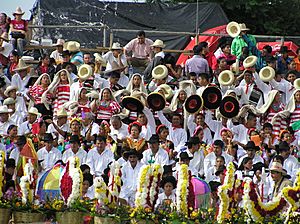
Mexican indigenous communities have rich cultures. They have many celebrations, traditional clothes, oral stories, special medicines, literature, unique buildings, and music. Each costume and dance often has a local historical and cultural meaning.
The Guelaguetza is a famous indigenous cultural event in Oaxaca. Another similar celebration is the Atlixcayotl in Atlixco, Puebla. While these events attract many tourists, they are very important for the indigenous people themselves. They help keep these cultures alive. Xantolo is another indigenous event in the Huastecas region. It is celebrated during the Day of the Dead.
Notable People
Historical Figures
-
Francisco Tenamaztle, a military leader. (Caxcan)
-
Juan Diego, a religious figure. (Nahua)
Modern Indigenous Mexicans
-
Geronimo, a military soldier. (Apache)
-
Cajemé, a military leader. (Yaqui)
-
Benito Juárez, a former president of Mexico. (Zapotec)
-
Ignacio Manuel Altamirano, a writer and politician. (Nahua)
-
Francisco Toledo, an activist and painter. (Zapotec)
-
Adela Calva Reyes, an activist and writer. (Otomi)
-
Armando Manzanero, a musician, singer, and composer. (Yucatec Maya)
-
Macedonia Blas Flores, an activist. (Otomi)
-
Yalitza Aparicio, an actress and model. (Mixtec and Triqui)
-
Tenoch Huerta, an actor and model. (Nahua)
Images for kids
-
Juan Diego, hoja religiosa, etching by José Guadalupe Posada (pre-1895).
-
Cuarenta Casas, ancient dwellings of the Mogollon culture.
-
Cemetery of San Juan Chamula.
-
A painting from 1777 showing the social classes in colonial Mexico.
-
Statue of Cajeme in Ciudad Obregón, Sonora.
-
"The Totonac Civilization," a mural by Diego Rivera in the National Palace celebrates Mexico's indigenous history.
-
Maya mother and child in Quintana Roo.
-
Francisco Luna Kan was governor of the state of Yucatán from 1976 to 1982.
-
Zapatista Army of National Liberation (EZLN), a revolutionary indigenous group in Chiapas.
-
Science and Indigenous education.
-
La Malinche, a historic figure. (Popoluca)
-
Tzilacatzin, a military soldier. (Otomi)
-
Francisco Toledo, an activist and painter. (Zapotec)
-
Amaranta Gómez Regalado, an activist and politician. (Zapotec)
See also
 In Spanish: Pueblos indígenas de México para niños
In Spanish: Pueblos indígenas de México para niños


